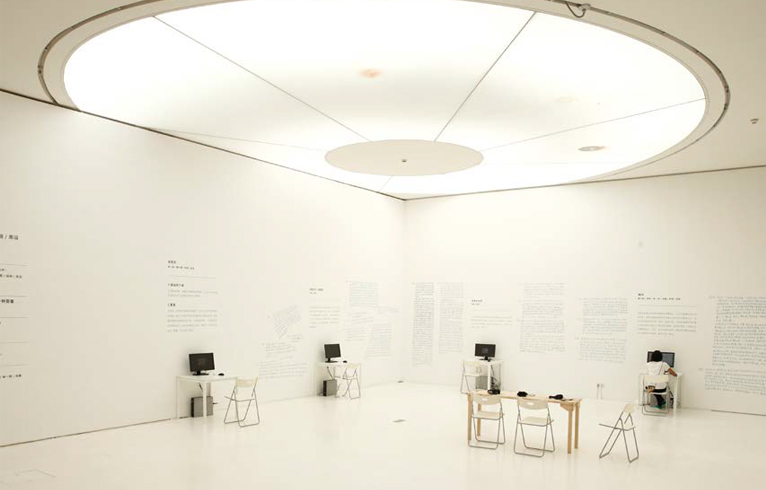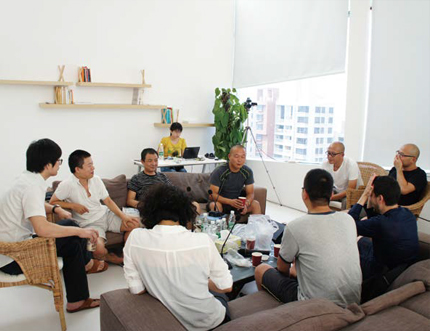PULSE REACTION— AN EXCHANGE PROJECT ON ART PRACTICE
| November 21, 2012 | Post In LEAP 17

ARTISTIC PRODUCTION IN THE POST-HISTORY AGE: HOW IS ART POSSIBLE AMIDST THE SOCIAL REALITIES OF TODAY?
DATE: 8.23-25
VENUE: Guangdong Times Museum
PARTICIPATING ARTISTS: Duan Jianyu, He An, Collin Chinnery, Wang Wei, Wang Yin, Zhang Hui, Zan Jbai, Zhu Yu
OBSERVER: Zheng Hongbin
“Pulse Reaction—An Exchange Project on Art Practice” at Guangdong Times Museum aims to bring the “non-material, non-productive but extremely enlightening moments in artistic practices” to the surface by way of rigorous discussion. Twenty-nine artists (and collectives) are divided into five groups, each with a different topic. “Through such intensive and diversified exchanges, we hope to explore in great depth the nature of certain issues and the footholds of our thinking. We work with participating artists in merging discussions, exhibitions, and publications in an open, interactive way. We look forward to the outcome of these encounters.” So writes the curator Shen Ruijun in the foreword.
LEAP sat in on the fourth discussion, the three-day “Artistic Production in the Post-History Age: How is Art Possible Amidst the Social Realities of Today?” and selected a few of the conversations on “statements” had therein.
Wang Yin I trust my intuition and try to avoid statements. I also like to look back at how the state of things comes into being, which has become a habit of mine. You could see this as my statement on reality.
He An There is a move in martial arts called “to hit the ox on the other side of the mountain,” which is also a way of artistic expression. Artists ought to be skilled at controlling their own power, and find their own ways of making statements.
Collin Chinnery Statements are inevitable. But it’s often difficult, dangerous and perhaps trite for the artist to make forthright statements about his time. I’m constantly searching for a non-constative approach to statements, which is quite a challenge. Sometimes I might be very content with my works, only to find them too direct, too trendy, or too reliant on the formal vocabularies of contemporary art practice. The question is how to avoid these pitfalls while maintaining a certain strength—which is in itself an unspoken statement about one’s time.
Zhu Yu I understand the eeriness of globalization that Wang Yin was talking about. I was thinking about whether reality was of any concern when the Song Emperor Huizong was painting. Maybe it was just a personal hobby or a calling of his. That some 2,000 people died building his imperial gardens probably didn’t affect him at all. It was just a price he had to pay for the gardens. Artists today are too often abducted by reality, thus unable to fully express their individual feelings and conditions. We all refer to the framework of a larger system and wonder how they might fit in. He An’s ideal of free creation bound by nothing but one’s own proclivities is, unfortunately, never realized.
Wang Yin I’m still thinking about the issue of statements and the convolution thereof. I’ve read Liang Qichao’s Introduction to the Learning of the Qing Dynasty and a book by Yu Ying-shih on the intellectual history of Ming and Qing. Both attribute the emergence of the Qianjia School and the drastic changes in Qing academia to the enthronement of the new dynasty. Scholars like Huang Zongxi and Gu Yanwu suffered greatly from the Manchu’s repression of the Han and thus devoted themselves to the study of exegetics and textology as a means of reflection rather than escape.

Wang Wei Same thing with Shen Congwen. He studied the history of Chinese clothing when he could no longer write.
Wang Yin Yu Ying-shih developed the concept of “inner logic.” He believes that exegetics was a political response of the Han scholars living under Qing rule. The study of words and research of specific dates were in fact their statements about reality, which I find very touching.
Duan Jianyu I’ve also thought a lot about the intricacy and convolution of making statements in my own practice. It’s a great challenge to a painter. Things sound clumsy and stupid when said out loud, and it’s hard to manifest one’s attitude in a smart way. But your work will surely come out as charming and powerful if you say it right.
Zhu Yu We are now entrapped by too many things, and have lost sight of the power and impact of the artwork before even making it, by struggling with issues of structural identification and situation. In other words, our attitude towards art is overly premature— be it resistant, nostalgic, pacifist, or radical, attitude should never become the premise of artistic creation. In fact, I believe that only after the completion of an artwork can its true relationship with society emerge. There has to be a delay. For example, the fact that a photo of the My Lai Massacre invokes both factual and fictional accounts attests to the work’s true relationship with reality. The photograph relates to its own time at the moment of materialization— the pressing of the shutter. Yet the relationship we are able to construct now cannot be but with the present. The power of the work lies precisely here, not in some preconception of the photographer’s. This is to say, we shouldn’t think too much before working, and instead consider the artwork’s relationship with society afterwards, whether or not it’s effective and expendable, just as how we approach whatever we did yesterday. We mustn’t destroy our work with predetermined concepts and values. It’s crucial that artists realize their creative drives and impulses to the fullest extent, regardless of how they may be situated in the system, or in society at large. I think this would be good enough. And the relationship, emerging with a delay, is the final judgment of the work.
Zhang Hui This is what I think about Zhu Yu’s question: we ought to consider the idea of the subject. Representation requires a subject, and our backgrounds and personal experiences often fill in that space. There was perhaps no need to worry about subjects when a “common standard” still existed— a concept that, as the fashionable narratives of post-history and fragmentation seem to suggest, has long departed. I think Zhu Yu’s working method is sustainable under this premise. Another viable method requires that the artist be constantly searching or creating a subject throughout his career, the very process of which becomes the subject of his art and thus the artwork. This is what I see in Duan Jianyu’s work: a combination of continuous thinking and continuous painting combined, which creates something more interesting. Zhu Yu’s recent paintings also reflect the interconnection and mutuality of art, the artist, and his relationship with society. (Translated by Connie Kang)

